
The Place Charles de Gaulle, historically known as the Place de l'Étoile, is a large road junction in Paris, France, the meeting point of twelve straight avenues including the Champs-Élysées. It was renamed in 1970, following the death of President Charles de Gaulle. It is still often referred to by its original name; the nearby Métro and RER station retains the designation Charles de Gaulle–Étoile. Paris's Axe historique cuts through the Arc de Triomphe, which stands at the centre of the Place Charles de Gaulle.
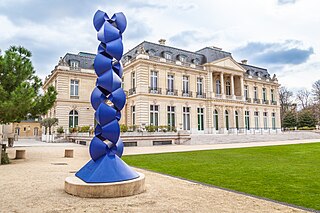
The 16th arrondissement of Paris is the westernmost of the 20 arrondissements of Paris, the capital city of France. Located on the Right Bank, it is adjacent to the 17th and 8th arrondissements to the northeast, as well as to Boulogne-Billancourt, Hauts-de-Seine to the southwest. Opposite the Seine are the 7th and 15th arrondissements.

The Boulevard Saint-Germain is a major street in Paris on the Rive Gauche of the Seine.

Wallace fountains are public drinking fountains named after, financed by and roughly designed by Sir Richard Wallace. The final design and sculpture is by Wallace's friend Charles-Auguste Lebourg. They are large cast-iron sculptures scattered throughout the city of Paris, France, mainly along the most-frequented sidewalks. A great aesthetic success, they are recognized worldwide as one of the symbols of Paris. A Wallace fountain can be seen outside the Wallace Collection in London, the gallery that houses the works of art collected by Sir Richard Wallace and the first four Marquesses of Hertford.

Nation station is a station of the Paris Métro and Île-de-France's RER commuter rail service. It serves Line 1, Line 2, Line 6 and Line 9 of the Paris Métro and RER A. It takes its name from its location at the Place de la Nation.

Saint Antoine Street, formerly known as Craig Street, is a street located in Montreal, Quebec, Canada. It runs to the south of Downtown Montreal and north of Old Montreal and Griffintown and Saint-Henri. It crosses the Quartier international de Montréal. Between Atwater Avenue and Greene Avenue, the north side of the street is in Westmount.

The Lycée Buffon is a secondary school in the XVe arrondissement of Paris, bordered by boulevard Pasteur, the rue de Vaugirard and the rue de Staël. Its nearest métro station is Pasteur. It is named for Georges-Louis Leclerc, comte de Buffon. Jean-Claude Durand is its current proviseur.
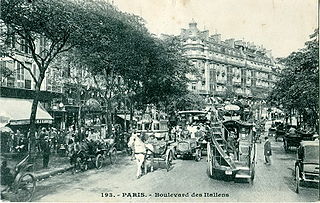
The Boulevard des Italiens is a boulevard in Paris. It is one of the 'Grands Boulevards' in Paris, a chain of boulevards built through the former course of the Wall of Charles V and the Louis XIII Wall, which were destroyed by the orders of Louis XIV. The origin of the name is the théâtre des Italiens built on it in 1783, shortly before the French Revolution on the site now occupied by the third Salle Favart.

The Place des Ternes is a square in the 8th and 17th arrondissements of Paris, at the junction of the Avenue de Wagram, the Boulevard de Courcelles, the Rue du Faubourg-Saint-Honoré and the Avenue des Ternes. It has borne its present name since 1893. In the middle of the square is the Paris Métro Line 2 station Ternes. It is located in the centre of one of the most vibrant communities of the city. The Place de Ternes is surrounded by various markets, parks, landmarks and local shops such as the Marché du Poncelet and Parc Monceau.
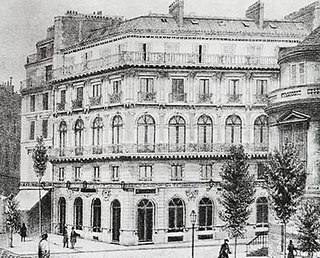
The Maison Dorée was a famous restaurant located at 20 Boulevard des Italiens, Paris.
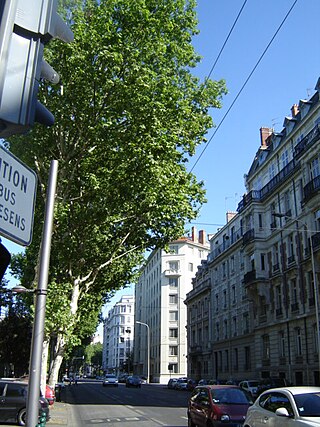
The Boulevard des Belges is a wide and posh avenue located in Les Brotteaux quarter, in the 6th arrondissement of Lyon. It begins with the Quai de Grande Bretagne, runs along the southern part of the Parc de la Tête d'Or until the Avenue Verguin and ends on the Place Jules Ferry, in front of the Gare des Brotteaux. The boulevard is lined with plane trees and is served by two velo'v stations and the line B of the metro.

The Porte de Vincennes is one of the city gates of Paris (France) situated in the Bel Air neighborhood of the 12th arrondissement.
This article presents the main landmarks in the city of Paris within administrative limits, divided by its 20 arrondissements. Landmarks located in the suburbs of Paris, outside of its administrative limits, while within the metropolitan area are not included in this article.

The Boulevard Voltaire is a well-known boulevard in the 11th arrondissement of Paris. It was created by Baron Georges-Eugène Haussmann during the reign of French emperor Napoleon III. Originally named the Boulevard du Prince-Eugène, it was renamed the Boulevard Voltaire on 25 October 1870 in honour of the French Enlightenment writer, historian, and philosopher Voltaire.

The Avenue Hoche is an avenue in the 8th arrondissement of Paris, France.

The Boulevard Soult is a boulevard in the Bel-Air neighborhood in the 12th arrondissement of Paris, France. It is one of the Boulevards of the Marshals that run in the outer parts of the city.
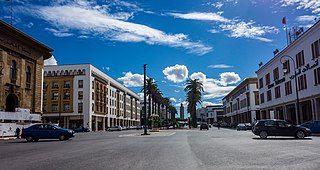
Avenue Mohammed V, sometimes referred to by its old name Avenue Dar al-Makhzen, is a major thoroughfare in downtown Rabat, Morocco. Its main section was created under the French Protectorate in Morocco and mostly developed between 1915 and 1932, when it was also known as Cours Lyautey. At the southern end of that section is the As-Sunna Mosque, whose history dates back to the 18th century like that of the nearby royal palace or Dar el-Makhzen.

















